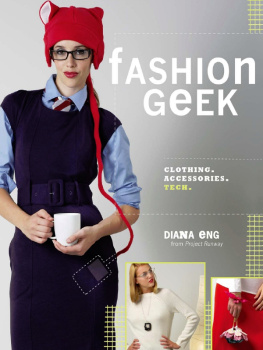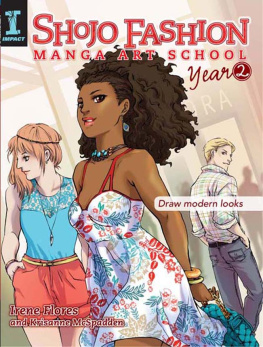
INTRODUCTION
This book looks at how to draw a fashion figure, developing techniques such as proportion, balance and other skills you will need to achieve striking results as an illustrator. It suggests exercises for loosening up and experimenting with your own style, and demonstrates how different garments react to and drape the body literally, how they clothe the figure. After that, you can try your hand at the more challenging issues such as drawing pattern, texture, stripes and plaids.
I t is nearly 25 years since I first started exploring the idea of becoming a fashion illustrator. From an early age I had wanted to draw it was the only thing that truly made me feel happy. I feel very fortunate that Ive been able to make a living from doing something I love.
Getting started as an illustrator is a combination of hard work and good luck. On graduating, I was fortunate enough to be accepted at Victor Edelstein, an old-school couturier in Mayfair, London. The clientele was made up of very wealthy women who wanted clothing with flattering cuts in luxurious fabrics. It was a great chance to see a professional at work, designing for some very demanding clients. The attention to detail was phenomenal; I drew Victors fashion designs either from mock-ups (known as toiles) or from his initial sketches. Several of my drawings were used in a brochure for his couture show in London. This was a great opportunity for my work to be seen by leading editors of British fashion magazines, and led to a call from Vogue.
This first commission started me on the path Im still on it hasnt always been steady, but its certainly been enjoyable. It has required determination and, more importantly, passion.

Inspiration
When I started out, inspiration was to be found in old leather-bound volumes of back copies of Vogue. I would spend hours poring over these in the library of my art college. They were full of drawings from the 40s and 50s, a golden period of illustration, and contained wonderful sketches by Marcel Verts, Christian Brard, Ren Gruau, Carl Erickson (Eric) and Ren Bouet-Willaumez, among others. They were a remarkable resource for anyone interested in illustration. The drawings dated from a time when photography wasnt allowed in magazines or at the big couture houses, so the new collections were captured by illustrators. This way of documenting fashion has seen a resurgence in recent years, as the Internet has opened up a world of resources, from museum websites and stock image sites to multifaceted sources of inspiration, such as Pinterest. By looking back at successful illustrators from different eras, you often hit upon a long-forgotten style that has a resonance in the modern world and can be given a fresh lease of life by way of an unconventional perspective. This has frequently worked for me. When I start a drawing, the hardest part is the first mark on the blank piece of paper. If I need to be inspired by other artists to make this mark, then I am happy to do so. Most illustrators have had to learn their style and technique from someone with experience only a very few are genuinely unique. Take Gladys Perint Palmer, for example, whose work has the freedom and looseness of Toulouse-Lautrec. She pays no regard to recording the hands in a realistic manner, but is more concerned with capturing the spirit of movement and the essence of the moment, and her work is all the more exhilarating for it.
Fine artists such as Toulouse-Lautrec, Matisse or Degas can inspire and enlighten your work with their wonderful use of line and color. Toulouse-Lautrec shows how to capture the character of an individual with an astonishing economy of line; the dynamic quality of his brushstrokes tells you that the painting has been done at pace, but with a skill that comes only from confidence. Gaining that confidence takes practice. Toulouse-Lautrec spent his nights endlessly drawing the characters who inhabited the bars and clubs of Paris. Similarly, Matisses figures possess a color and boldness that is intoxicating, and using his paper cut-outs as templates is a great way to get started with collage.
I draw quickly; I hate having to sit and draw the same thing for more than half an hour. In life-drawing classes, I move around sketching the model from different angles, otherwise I get bored and it shows in the drawing. While unlike Toulouse-Lautrec we no longer have access to the bars and bordellos of 19th-century Paris, sketching backstage at a fashion show has a similar sense of chaotic movement and fleeting moments. Just being in among the anarchy and glamour and trying to capture a beautiful model in an outfit or, better still, managing to nail the spirit of the whole show, is exhilarating.
Vivienne Westwoods designs, with her wonderful silhouettes, historical references and use of fabrics, encapsulate the movement and passion that swirls around at a fashion show. Trying to capture tartan in an easy and uncontrived way is hard enough, but doing so surrounded by the distractions and noise of a party atmosphere and the great characters and stridently individual models who Westwood uses is enough to test the hardiest of souls.

A fashion illustration inspired by the ballerina poses of Edgar Degas
Getting your personality across
Expressing yourself artistically is a very individual process, and you should experiment widely and always be open to surprises. The objective is not to set yourself rules or habits for their own sake, but to find the tools you need to say what you want to say. Confidence plays a big part in this; some people are happy to use a chunky marker pen from the off, others may be worried about making a mistake; they may prefer to use an HB pencil or something else that can easily be erased.
A successful illustrator of childrens books once told me that when she started out she was influenced by early Russian animators. She had some success in getting her books published, but then the work seemed to dry up. So she went and did some more research and tried drawing in an American 50s style, but again, after some initial interest, the work didnt really take off. Throughout this period she continued going out and sketching things that interested her in a hardback sketchbook. It was while looking through some of these books of her drawings, with their strong, bold lines, that a question struck her: Why use other peoples styles when there is a perfectly acceptable natural style all of my own, staring me in the face? Once she started to work in her own unique way, the commissions began to flood in.
Learning from the past
Without a working knowledge of the artists and illustrators of the past, it is impossible to create for the future. Pioneers such as Georges Lepape and Paul Iribe illustrated the gorgeous garments of Paul Poiret, a couturier who inspired modern designers such as John Galliano and Alexander McQueen. Although the poses may look wooden by modern standards, their compositions and background details reward study. The figures have a doll-like quality, with delicately rounded hands that are no longer seen in contemporary drawings.
Artists who have inspired me include Egon Schiele, whose ground-breaking approach to figurative painting is still relevant today. Ive often happened upon one of his drawings by accident and thought, Wow, what a great piece of contemporary illustration!, only to realize that its a Schiele sketch, probably drawn over a hundred years ago. Lon Bakst produced wonderfully theatrical costume illustrations, heady with oriental details and full of pattern, color and the flowing grace of dance. Hes a great artist to look at for ideas regarding layout and pose. His works for the Ballets Russes are superb. Baksts brilliant control of color, line and decoration give his stage illustrations a visual flow in which color is used emotionally and sensuously. Look at his work alongside that of Ert (Romain de Tirtoff), a Russian-born French artist and designer who created over-the-top, stylized images of women in theatrical settings, overflowing with exaggerated poses and costumes.
Next page












